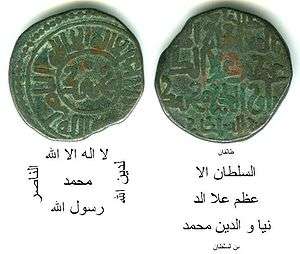Taloqan
| Tāloqān طالوقان طالقان | |
|---|---|
| City | |
|
market street in Taloqan | |
 Tāloqān Location in Afghanistan | |
| Coordinates: 36°43′N 69°31′E / 36.717°N 69.517°ECoordinates: 36°43′N 69°31′E / 36.717°N 69.517°E | |
| Country |
|
| Province | Takhār Province |
| District | Taluqan District |
| Elevation | 876 m (2,874 ft) |
| Population (2006) | |
| • Total | 196,400 |
| Time zone | Afghanistan Standard Time (UTC+4:30) |
Tāloqān (Persian/Pashto: طالقان, also transcribed Tāleqān or Tāluqān) is the capital of Takhar Province, in northeastern Afghanistan. It is located in the Taluqan District. The population was estimated as 196,400 in 2006.[1]
History

The old city to the west on the riverside was described by Marco Polo in 1275 CE as:
- "a castle called Taikhan, where there is a great corn-market, and the country round is fine and fruitful. The hills that lie to the south of it are large and lofty. They all consist of white salt, extremely hard, with which the people for a distance of thirty days' journey round, come to provide themselves, for it is esteemed the purest that is found in the world. It is so hard, that it can be broken only with great iron hammers. The quantity is so great that all the countries of the earth might be supplied from thence."[2]
In 1603, Taloqan ("Talhan") was visited by another European explorer, Bento de Góis, who was traveling with a caravan from Kabul to Yarkand (then the capital of Kashgaria).[3]
Recent history
Taloqan was the last major city to fall to the Taliban, in January 2001, after a siege which claimed the lives of hundreds of civilians.[4] Its capture by the Taliban also triggered a mass exodus in the population, with civilians fleeing towards Imam Sahib and the Panjshir Valley. Irregular Northern Alliance soldiers managed to stop the Taliban advance to the north and to the east of the city, but weren't able to retake it. Taloqan was besieged again in a bloody siege in November 2001 by Northern Alliance soldiers, a mass grave containing the bodies of 70 women and children was found, they had been brutally murdered for no reason other than possibly being the families of captured fighters and were ethnic Pashtuns.
Taloqan in Islamic sources
The testament of the Islamic prophet, Mohammad, indicates that the first Mahdi is called “Ahmad”, and then we look into the narrations that refer to Al-Yamani, such as the narrations of the black standards, the treasures of Taloqan, the standards of Khurasan and the standards of the east, because there are no narrations that describe them as being disobedient or insubordinate to the standard of Al-Yamani, for he who revolts against him (Al-Yamani) will be cast into the Fire, and all the narrations confirm that those standards will fight to pave the way for the advent of Imam Al-Mahdi.
Following the same narrative chain, Al-Baqir narrated the following on the authority of Jabir: [Allah Almighty has a treasure in Taloqan; it is of neither gold nor silver but consists of twelve thousand (men) in Khurasan, having “Ahmad Ahmad” for emblem. They will be led by a Hashemite young man riding a gray mule and wearing a red headband. I can almost see him crossing the Euphrates; should you hear of his coming, rush to him even if you have to crawl over the snow.].[5][6][7][8][9][10][11]
Taloqan (a region in Afghanistan) that at that place are treasures of Allah, but these are not of gold and silver but consist of people who have recognised Allah as they should have. (Al-Muttaqi al-Hindi, Al-Burhan fi Alamat al-Mahdi Akhir al-zaman, p. 59)
See also
References
- ↑ "Tāloqān". World Gazetteer. Archived from the original on 2013-01-05. Retrieved 2007-12-19.
- ↑ Dupree, Nancy Hatch (1977) [1st Edition: 1970]. An Historical Guide to Afghanistan (2nd Edition, Revised and Enlarged ed.). Afghan Tourist Organization.
- ↑ "The Journey of Benedict Goës from Agra to Cathay" - Henry Yule's translation of the relevant chapters of De Christiana expeditione apud Sinas, with detailed notes and an introduction. In: Yule (translator and editor), Sir Henry (1866). Cathay and the way thither: being a collection of medieval notices of China. Issue 37 of Works issued by the Hakluyt Society. Printed for the Hakluyt society. pp. 558–559.
- ↑ Filipov, David (10/06/2002). "Amid the ruins of war, Afghans tread warily". The Boston Globe. Retrieved 2007-12-19. Check date values in:
|date=(help) - ↑ Al-Yamani, the First of the Mahdis - A-Name Correspondence http://the-savior.com/home/muslims/shiaa-muslims/al-yamani-the-first-of-the-mahdis/Page-2.html
- ↑ http://sahabatnabi.0catch.com/imammahdi3.htm
- ↑ The Narrations of Imam Ali and several Companions of the Holy Prophet praise and peace be upon him concerning Al Mahdi http://kawansejati.ee.itb.ac.id/0321-the-narrations-of-imam-ali-and-several-companions-of-the-holy-prophet-praise-and-peace-be-upon-him-concerning-al-mahdi
- ↑ Hadis Al-Mahdiyul Muntazar:"Good for Al Talakan! Surely, for Allah in it are treasures, not of gold or silver but men who know Allah through truthful knowledge and they will support Al Mahdi at the end of Time."
- ↑ E-Book: AL MAHDI, JESUS and MOSHAIKH [theANTI-CHRIST] http://www.scribd.com/doc/55997507/AL-MAHDI
- ↑ http://imam7mahdi.wordpress.com/category/lampiran/
- ↑ http://ebook.mw.lt/jowo/txtimam4.txt
.jpg)